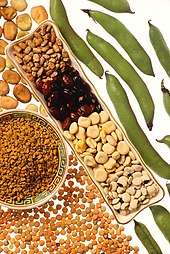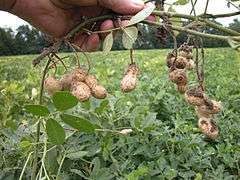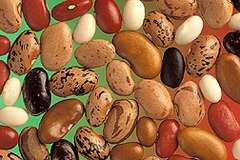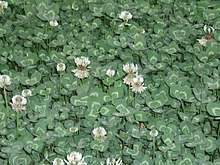Legume

A legume (/ˈlɛɡjuːm,
A legume fruit is a simple dry fruit that develops from a simple carpel and usually dehisces (opens along a seam) on two sides. A common name for this type of fruit is a pod, although the term "pod" is also applied to a number of other fruit types, such as that of vanilla (a capsule) and of the radish (a silique).
Legumes are notable in that most of them have symbiotic nitrogen-fixing bacteria in structures called root nodules. For that reason, they play a key role in crop rotation.
Terminology
The term "pulse", as used by the United Nations' Food and Agriculture Organization (FAO), is reserved for crops harvested solely for the dry seed.[1] This excludes green beans and green peas, which are considered vegetable crops. Also excluded are seeds that are mainly grown for oil extraction (oilseeds like soybeans and peanuts), and seeds which are used exclusively for sowing forage (clovers, alfalfa). However, in common usage, these distinctions are not always clearly made, and many of the varieties used for dried pulses are also used for green vegetables, with their beans in pods while young.
Some Fabaceae, such as Scotch broom and other Genisteae, are leguminous but are usually not called legumes by farmers, who tend to restrict that term to food crops.
Uses
Farmed legumes can belong to many agricultural classes, including forage, grain, blooms, pharmaceutical/industrial, fallow/green manure, and timber species. Most commercially farmed species fill two or more roles simultaneously, depending upon their degree of maturity when harvested.
Human consumption

Grain legumes are cultivated for their seeds. The seeds are used for human and animal consumption or for the production of oils for industrial uses. Grain legumes include beans, lentils, lupins, peas, and peanuts.[2]
Nutritional value
Legumes are a significant source of protein, dietary fiber, carbohydrates and dietary minerals; for example, a 100 gram serving of cooked chickpeas contains 18 percent of the Daily Value (DV) for protein, 30 percent DV for dietary fiber, 43 percent DV for folate and 52 percent DV for manganese.[3] Like other plant-based foods, pulses contain no cholesterol and little fat or sodium.[3]
Legumes are also an excellent source of resistant starch which is broken down by bacteria in the large intestine to produce short-chain fatty acids (such as butyrate) used by intestinal cells for food energy.[4]
Preliminary studies in humans include the potential for regular consumption of legumes in a plant-based diet to reduce the prevalence or risk of developing metabolic syndrome.[5] There is evidence that a portion of pulses (roughly one cup daily) in a diet may help lower blood pressure and reduce LDL cholesterol levels, though there is a concern about the quality of the supporting data.[6][7]
Commodity classification

FAO recognizes 11 primary pulses.[8]
- Dry beans (FAOSTAT code 0176, Phaseolus spp. including several species now in Vigna)
- Kidney bean, navy bean, pinto bean, haricot bean (Phaseolus vulgaris)
- Lima bean, butter bean (Phaseolus lunatus)
- Adzuki bean, azuki bean (Vigna angularis)
- Mung bean, golden gram, green gram (Vigna radiata)
- Black gram, urad (Vigna mungo)
- Scarlet runner bean (Phaseolus coccineus)
- Ricebean (Vigna umbellata)
- Moth bean (Vigna aconitifolia)
- Tepary bean (Phaseolus acutifolius)
- Dry broad beans (code 0181, Vicia faba)
- Horse bean (Vicia faba equina)
- Broad bean (Vicia faba)
- Field bean (Vicia faba)
- Dry peas (code 0187, Pisum spp.)
- Garden pea (Pisum sativum var. sativum)
- Protein pea (Pisum sativum var. arvense)
- Chickpea, garbanzo, Bengal gram (code 0191, Cicer arietinum)
- Dry cowpea, black-eyed pea, blackeye bean (code 0195, Vigna unguiculata )
- Pigeon pea, Arhar/Toor, cajan pea, Congo bean, gandules (code 0197Cajanus cajan)
- Lentil (code 0201, Lens culinaris)
- Bambara groundnut, earth pea (code 0203, Vigna subterranea)
- Vetch, common vetch (code 0205, Vicia sativa)
- Lupins (code 0210, Lupinus spp.)
- Pulses NES (code 0211), Minor pulses, including:
- Lablab, hyacinth bean (Lablab purpureus)
- Jack bean (Canavalia ensiformis), sword bean (Canavalia gladiata)
- Winged bean (Psophocarpus tetragonolobus)
- Velvet bean, cowitch (Mucuna pruriens var. utilis)
- Yam bean (Pachyrhizus erosus)
Forage

Forage legumes are of two broad types. Some, like alfalfa, clover, vetch (Vicia), stylo (Stylosanthes), or Arachis, are sown in pasture and grazed by livestock. Other forage legumes such as Leucaena or Albizia are woody shrub or tree species that are either broken down by livestock or regularly cut by humans to provide livestock feed.
Other uses
.jpg)
Legume species grown for their flowers include lupins, which are farmed commercially for their blooms as well as being popular in gardens worldwide. Industrially farmed legumes include Indigofera and Acacia species, which are cultivated for dye and natural gum production, respectively. Fallow/green manure legume species are cultivated to be tilled back into the soil in order to exploit the high levels of captured atmospheric nitrogen found in the roots of most legumes. Numerous legumes farmed for this purpose include Leucaena, Cyamopsis, and Sesbania species. Various legume species are farmed for timber production worldwide, including numerous Acacia species and Castanospermum australe.
Legume trees like the locust trees (Gleditsia, Robinia) or the Kentucky coffeetree (Gymnocladus dioicus) can be used in permaculture food forests. Other legume trees like laburnum and the woody climbing vine wisteria are poisonous.
Nitrogen fixation
Many legumes contain symbiotic bacteria called Rhizobia within root nodules of their root systems. (Plants belonging to the genus Styphnolobium are one exception to this rule.) These bacteria have the special ability of fixing nitrogen from atmospheric, molecular nitrogen (N2) into ammonia (NH3).[9] The chemical reaction is:
- N2 + 8H+ + 8e− → 2NH3 + H2
Ammonia is then converted to another form, ammonium (NH+
4), usable by (some) plants by the following reaction:
- NH3 + H+ → NH+
4
This arrangement means that the root nodules are sources of nitrogen for legumes, making them relatively rich in plant proteins. All proteins contain nitrogenous amino acids. Nitrogen is therefore a necessary ingredient in the production of proteins. Hence, legumes are among the best sources of plant protein.
When a legume plant dies in the field, for example following the harvest, all of its remaining nitrogen, incorporated into amino acids inside the remaining plant parts, is released back into the soil. In the soil, the amino acids are converted to nitrate (NO−
3), making the nitrogen available to other plants, thereby serving as fertilizer for future crops.[10][11]
In many traditional and organic farming practices, crop rotation involving legumes is common. By alternating between legumes and nonlegumes, sometimes planting nonlegumes two times in a row and then a legume, the field usually receives a sufficient amount of nitrogenous compounds to produce a good result, even when the crop is nonleguminous. Legumes are sometimes referred to as "green manure".
History
Archaeologists have discovered traces of pulse production around Ravi River (Punjab), the seat of the Indus Valley Civilisation, dating to c. 3300 BCE. Meanwhile, evidence of lentil cultivation has also been found in Egyptian pyramids and cuneiform recipes.[12] Dry pea seeds have been discovered in a Swiss village that are believed to date back to the Stone Age. Archaeological evidence suggests that these peas must have been grown in the eastern Mediterranean and Mesopotamian regions at least 5,000 years ago and in Britain as early as the 11th century.[13]
Distribution and economy
| Country | Production (thousands of tonnes) | ||||
|---|---|---|---|---|---|
Legumes are widely distributed as the third-largest land plant family in terms of number of species, behind only the Orchidaceae and Asteraceae, with about 751 genera and some 19,000 known species,[16][17] constituting about seven percent of flowering plant species.[18][19]
India is the world's largest producer as well as consumer of pulses. In order to meet its large domestic demand of pulses, India has to import the produce from other countries contrary to its large production.
International Year of Pulses
The International Year of Pulses 2016 (IYP 2016) was declared by the Sixty-eighth session of the United Nations General Assembly.[20] The Food and Agriculture Organization of the United Nations was nominated to facilitate the implementation of IYP 2016 in collaboration with governments, relevant organizations, non-governmental organizations and other relevant stakeholders. Its aim was to heighten public awareness of the nutritional benefits of pulses as part of sustainable food production aimed towards food security and nutrition. IYP 2016 created an opportunity to encourage connections throughout the food chain that would better utilize pulse-based proteins, further global production of pulses, better utilize crop rotations and address challenges in the global trade of pulses.[20][21]
See also
References
- ↑ "What is a Pulse?". Pulse Canada. Pulse Canada. Retrieved 26 June 2016.
- ↑ The gene bank and breeding of grain legumes (lupine, vetch, soya, and beah), B.S. Kurlovich and S.I. Repyev (eds.), St. Petersburg: N. I. Vavilov Institute of Plant Industry, 1995, 438p. – (Theoretical basis of plant breeding. V.111)
- 1 2 "Nutrition facts for Chickpeas (garbanzo beans, bengal gram), mature seeds, cooked, boiled, without salt, 100 g, USDA Nutrient Database, version SR-21". Conde Nast. 2014. Retrieved 15 January 2015.
- ↑ Birt, D. F.; et al. (2013). "Resistant Starch: Promise for Improving Human Health". Advances in Nutrition. 4 (6): 587–601. doi:10.3945/an.113.004325. PMC 3823506. PMID 24228189.
- ↑ Sabaté, Joan; Wien, Michelle (2015). "A perspective on vegetarian dietary patterns and risk of metabolic syndrome". British Journal of Nutrition. 113 (Suppl 2): S136–43. doi:10.1017/S0007114514004139. PMID 26148917.
- ↑ Jayalath VH, de Souza RJ, Sievenpiper JL, et al. (January 2014). "Effect of dietary pulses on blood pressure: a systematic review and meta-analysis of controlled feeding trials". American Journal of Hypertension. 27 (1): 56–64. doi:10.1093/ajh/hpt155. PMID 24014659.
- ↑ Ha, Vanessa (May 13, 2014). "Effect of dietary pulse intake on established therapeutic lipid targets for cardiovascular risk reduction: a systematic review and meta-analysis of randomized controlled trials". Canadian Medical Association Journal. 186 (8): 586. doi:10.1503/cmaj.131727. PMC 4016088. PMID 24710915.
- 1 2 FAO Pulses and Derived Products
- ↑ Deacon, Jim. "The Nitrogen cycle and Nitrogen fixation". Institute of Cell and Molecular Biology, The University of Edinburgh. Retrieved March 1, 2015.
- ↑ Postgate, John (1998). Nitrogen Fixation (3rd ed.). Cambridge University Press. ISBN 978-0-521-64853-0.
- ↑ Smil, Vaclav (2000). Cycles of Life. Scientific American Library.
- ↑ Albala, Ken (2007). "Lentils: Fertile Crescent". Beans: A History. New York: Berg Publishers. p. 18. ISBN 978-0-8578-5078-2.
The earliest culinary texts to have survived are in the form of three cuneiform tablets dated to about 1600 BCE. [...] [T]ucked away among a series of porridges there is one recipe for husked lentils [...]. [I]n any case it is the very oldest explicit legume recipe on earth. [...] The Egyptians also used lentils as funerary offerings and in meals to feed the dead in the underworld. Large stores were found beneath Zoser's pyramid [...].
- ↑ Mat Chaudhry Green Gold: Value-added pulses Quantum Media ISBN 1-61364-696-8
- ↑ see legume#Commodity Classification
- ↑ "Countries by commodity - Pulses (2016)". UN Food & Agriculture Organization. Retrieved 13 June 2018.
- ↑ Christenhusz, M. J. M.; Byng, J. W. (2016). "The number of known plants species in the world and its annual increase". Phytotaxa. Magnolia Press. 261 (3): 201–217. doi:10.11646/phytotaxa.261.3.1.
- ↑ Stevens, P. F. "Fabaceae". Angiosperm Phylogeny Website. Version 7 May 2006. Retrieved 28 April 2008.
- ↑ Judd, W. S., Campbell, C. S. Kellogg, E. A. Stevens, P.F. Donoghue, M. J. (2002), Plant systematics: a phylogenetic approach, Sinauer Axxoc, 287-292. ISBN 0-87893-403-0.
- ↑ Magallón, S. A., and Sanderson, M. J.; Sanderson (2001). "Absolute diversification rates in angiosperm clades" (PDF). Evolution. 55 (9): 1762–1780. doi:10.1111/j.0014-3820.2001.tb00826.x. PMID 11681732. Archived from the original (PDF) on 2013-10-19.
- 1 2 United Nations, David. "The International Year of Pulses". United Nations. Retrieved 14 December 2015.
- ↑ "International Year of Pulses 2016 - IYP2016". Retrieved 14 December 2015.
Further reading
- "Pulses". NHS Choices. April 30, 2013. Retrieved January 9, 2017.
- Varshney, Rajeev K.; Kudapa, Himabindu (November 2013). "Legume biology: the basis for crop improvement" (PDF). Functional Plant Biology. CSIRO Publishing. 40 (12): v–viii. doi:10.1071/FPv40n12_FO.
External links
| Look up legume in Wiktionary, the free dictionary. |
| Wikimedia Commons has media related to Legumes. |